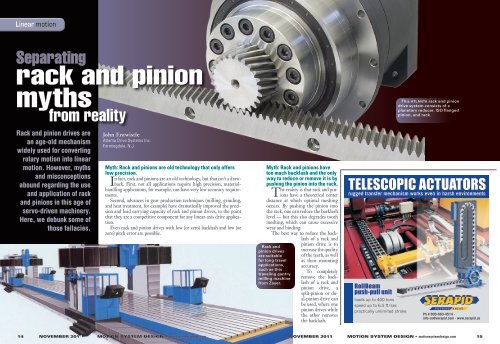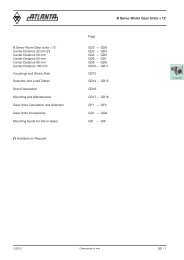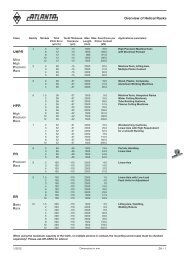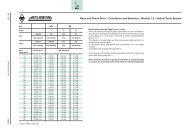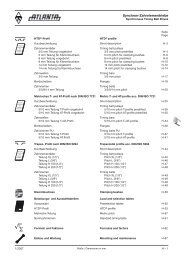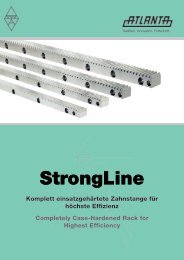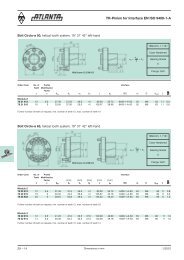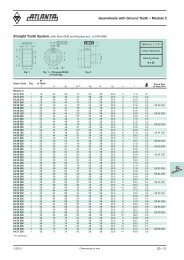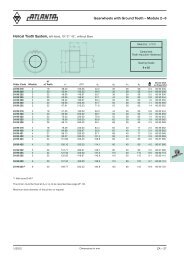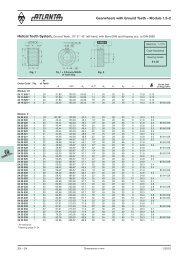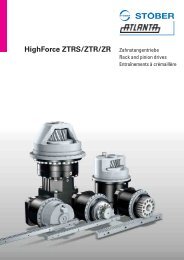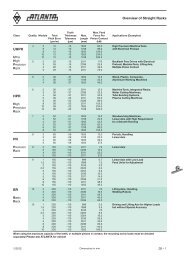rack and pinion
rack and pinion
rack and pinion
Create successful ePaper yourself
Turn your PDF publications into a flip-book with our unique Google optimized e-Paper software.
Linear motion<br />
Separating<br />
<strong>rack</strong> <strong>and</strong> <strong>pinion</strong><br />
myths<br />
from reality<br />
This ATLANTA <strong>rack</strong> <strong>and</strong> <strong>pinion</strong><br />
drive system consists of a<br />
planetary reducer, ISO flanged<br />
<strong>pinion</strong>, <strong>and</strong> <strong>rack</strong>.<br />
Rack <strong>and</strong> <strong>pinion</strong> drives are<br />
an age-old mechanism<br />
widely used for converting<br />
rotary motion into linear<br />
motion. However, myths<br />
<strong>and</strong> misconceptions<br />
abound regarding the use<br />
<strong>and</strong> application of <strong>rack</strong><br />
<strong>and</strong> <strong>pinion</strong>s in this age of<br />
servo-driven machinery.<br />
Here, we debunk some of<br />
those fallacies.<br />
John Entwistle<br />
Atlanta Drive Systems Inc.<br />
Farmingdale, N.J.<br />
Myth: Rack <strong>and</strong> <strong>pinion</strong>s are old technology that only offers<br />
low precision.<br />
In fact, <strong>rack</strong> <strong>and</strong> <strong>pinion</strong>s are an old technology, but that isn’t a drawback.<br />
First, not all applications require high precision; materialh<strong>and</strong>ling<br />
applications, for example, can have very low accuracy requirements.<br />
Second, advances in gear production techniques (milling, grinding,<br />
<strong>and</strong> heat treatment, for example) have dramatically improved the precision<br />
<strong>and</strong> load carrying capacity of <strong>rack</strong> <strong>and</strong> <strong>pinion</strong> drives, to the point<br />
that they are a competitive component for any linear-axis drive application.<br />
Even <strong>rack</strong> <strong>and</strong> <strong>pinion</strong> drives with low (or zero) backlash <strong>and</strong> low (or<br />
zero) pitch error are possible.<br />
Myth: Rack <strong>and</strong> <strong>pinion</strong>s have<br />
too much backlash <strong>and</strong> the only<br />
way to reduce or remove it is by<br />
pushing the <strong>pinion</strong> into the <strong>rack</strong>.<br />
reality is that <strong>rack</strong> <strong>and</strong> pin-<br />
The ions have a theoretical center<br />
distance at which optimal meshing<br />
occurs. By pushing the <strong>pinion</strong> into<br />
the <strong>rack</strong>, one can reduce the backlash<br />
level — but this also degrades tooth<br />
meshing, which can cause excessive<br />
wear <strong>and</strong> binding.<br />
The best way to reduce the backlash<br />
of a <strong>rack</strong> <strong>and</strong><br />
Rack <strong>and</strong><br />
<strong>pinion</strong> drives<br />
are suitable<br />
for long travel<br />
applications,<br />
such as this<br />
traveling gantry<br />
milling machine<br />
from Zayer.<br />
<strong>pinion</strong> drive is to<br />
increase the quality<br />
of the teeth, as well<br />
as their mounting<br />
accuracy.<br />
To completely<br />
remove the backlash<br />
of a <strong>rack</strong> <strong>and</strong><br />
<strong>pinion</strong> drive, a<br />
split-<strong>pinion</strong> or dual-<strong>pinion</strong><br />
drive can<br />
be used, where one<br />
<strong>pinion</strong> drives while<br />
the other removes<br />
the backlash.<br />
TELESCOPIC ACTUATORS<br />
rugged transfer mechanism works even in harsh environments<br />
RollBeam<br />
push-pull unit<br />
loads up to 400 tons<br />
speed up to 6.5 ft/sec<br />
practically unlimited stroke<br />
Ph # 800-663-4514 ·<br />
info-us@serapid.com · www.serapid.us<br />
14 NOVEMBER 2011 MOTION SYSTEM DESIGN • motionsystemdesign.com<br />
NOVEMBER 2011<br />
MOTION SYSTEM DESIGN • motionsystemdesign.com<br />
15
Linear motion<br />
A split <strong>pinion</strong> can be<br />
used to eliminate axis<br />
backlash <strong>and</strong> provide<br />
precise positioning <strong>and</strong><br />
repeatability.<br />
DYNAMIC SOLUTIONS<br />
A&A Manufacturing Company<br />
is your single-source provider<br />
of innovative protective cover<br />
products for:<br />
Ball screws<br />
Precision slides<br />
Robots<br />
Linear rails & motors<br />
Machine ways<br />
The widest variety of<br />
technologies <strong>and</strong> materials<br />
are used to protect in any<br />
environmental condition.<br />
A&A can design <strong>and</strong> deliver<br />
exactly what you need to keep<br />
your equipment in motion.<br />
CUSTOM ENGINEERED<br />
FOR YOUR APPLICATION<br />
Myth: Rack <strong>and</strong><br />
<strong>pinion</strong>s can’t<br />
be used in dirty<br />
environments.<br />
Rack <strong>and</strong> <strong>pinion</strong>s are<br />
considered open<br />
gearing because they are not<br />
enclosed in a housing, so foreign<br />
debris can find its way into the tooth<br />
mesh <strong>and</strong> cause damage. However,<br />
MSD_AAGortite_quarterpage_3.25x4.625.pdf 1 1/21/11 1:38 PM<br />
A Division of A&A Manufacturing<br />
www.Gortite.com<br />
Email: sales@gortite.com<br />
Toll Free: 800-298-2066<br />
Fax: 262-786-3280<br />
orienting the <strong>rack</strong> teeth on their side<br />
or facing down can minimize this.<br />
Linear bellows or covers can also be<br />
used to protect the drive.<br />
By using an automatic lubrication<br />
system with a felt gear applicator,<br />
any debris on the tooth flanks can<br />
be wiped away so damage is prevented.<br />
Likewise, for washdown or<br />
wet environments, using stainlesssteel<br />
<strong>rack</strong> <strong>and</strong> <strong>pinion</strong>s prevents corrosion.<br />
Myth: Rack <strong>and</strong> <strong>pinion</strong>s can<br />
have excessive errors at<br />
the joint between two <strong>rack</strong><br />
sections.<br />
In reality, to achieve the desired<br />
travel length, multiple pieces of<br />
<strong>rack</strong> may be mounted end-to-end.<br />
From 0.396” to 26” Diameters<br />
Stainless Steel, Inconel,<br />
Titanium, <strong>and</strong> Hastelloy<br />
materials<br />
Custom End Pieces<br />
Two-Ply Construction Available<br />
During assembly, errors can be induced<br />
into the drive where the <strong>rack</strong><br />
sections butt together. However,<br />
using a “companion” <strong>rack</strong>, which<br />
meshes between the two <strong>rack</strong> sections,<br />
can minimize this error. Otherwise,<br />
perfect <strong>rack</strong> joints with no<br />
error can be achieved by using <strong>rack</strong><br />
assembly kits, which allow for joints<br />
to be precisely measured <strong>and</strong> any error<br />
eliminated.<br />
Myth: Rack <strong>and</strong> <strong>pinion</strong>s have<br />
pitch errors that can accumulate<br />
over a long travel length.<br />
For long axis drives, multiple<br />
pieces of <strong>rack</strong> may be mounted<br />
end-to-end to achieve the desired<br />
travel length. Although each piece<br />
of <strong>rack</strong> has an overall pitch error<br />
associated with it, this error can be<br />
controlled or even eliminated so<br />
that there is no accumulated error<br />
over the full travel length.<br />
Depending on the quality of the<br />
<strong>rack</strong> teeth, the pitch error can be<br />
between 0.012 <strong>and</strong> 0.200 mm per<br />
meter length. It is also possible to<br />
mount <strong>rack</strong>s in a predefined order<br />
to always have the total pitch error<br />
100<br />
hover around zero.<br />
Myth: Split-<strong>pinion</strong>s use<br />
75<br />
springs to remove the mesh<br />
backlash, which can deflect<br />
while operating.<br />
Actually, split-<strong>pinion</strong>s consist<br />
of two <strong>pinion</strong> halves —<br />
25<br />
5<br />
one which is fixed, <strong>and</strong> one which<br />
is axially spring-loaded. Before<br />
0<br />
operating, the split-<strong>pinion</strong> is<br />
100<br />
first adjusted to remove the mesh<br />
backlash; it is then preloaded 95to<br />
compress the spring up to the operating<br />
load of the application.<br />
75<br />
Preloading the spring ensures<br />
that the spring will not deflect<br />
under load during operation. 25In<br />
fact, when the preload is set properly,<br />
the spring will not move at<br />
5<br />
all<br />
during operation. The only way<br />
0<br />
the spring could deflect further is<br />
if the operating load exceeds the<br />
preload setting.<br />
95<br />
An automatic<br />
lubrication system<br />
using a felt gear<br />
applicator provides<br />
continuous<br />
lubrication of the<br />
<strong>rack</strong> <strong>and</strong> <strong>pinion</strong><br />
tooth flanks.<br />
SERAPID Inc, ACTUATORS / LB 09-10 LINEA · TEXT + DESIGN<br />
Sonntag, 12. September 2010 16:50:53<br />
Farbprofil: Deaktiviert<br />
Composite St<strong>and</strong>ardbildschirm<br />
1<br />
10<br />
95<br />
75<br />
25<br />
5<br />
0<br />
10<br />
95<br />
75<br />
25<br />
5<br />
0<br />
16 NOVEMBER 2011 MOTION SYSTEM DESIGN • motionsystemdesign.com<br />
NOVEMBER 2011<br />
MOTION SYSTEM DESIGN • motionsystemdesign.com<br />
17
Linear motion<br />
A helical <strong>rack</strong> <strong>and</strong> <strong>pinion</strong> drive from ATLANTA is suitable for myriad<br />
linear-motion applications.<br />
Myth: Rack <strong>and</strong> <strong>pinion</strong>s can’t<br />
provide the same performance<br />
as ballscrews <strong>and</strong> roller-<strong>pinion</strong><br />
drives.<br />
In fact, ballscrews often provide<br />
adequate performance for axis<br />
drives requiring precise positioning<br />
<strong>and</strong> repeatability — by having low<br />
backlash <strong>and</strong> pitch error. Where<br />
required, zero backlash can be<br />
achieved by using preloaded nuts.<br />
Rack <strong>and</strong> <strong>pinion</strong>s can also achieve<br />
precise positioning <strong>and</strong> repeatability.<br />
By using hardened <strong>and</strong> ground<br />
tooth flanks, low backlash <strong>and</strong> pitch<br />
error can be achieved; zero backlash<br />
can be achieved by using split-<strong>pinion</strong><br />
or dual-<strong>pinion</strong> drives.<br />
For long <strong>and</strong> heavy axis drives,<br />
such as those found in the machine<br />
tool <strong>and</strong> aerospace industries, <strong>rack</strong><br />
<strong>and</strong> <strong>pinion</strong>s can actually outperform<br />
ballscrews, because the travel<br />
lengths of the latter can be limited<br />
by their buckling strength <strong>and</strong> whip.<br />
For high-speed applications, <strong>rack</strong><br />
<strong>and</strong> <strong>pinion</strong> drives can also h<strong>and</strong>le<br />
higher linear speeds (up to six meters<br />
per second) than ballscrews.<br />
Roller-<strong>pinion</strong>s are a system that<br />
uses rollers instead of teeth to engage<br />
a <strong>rack</strong>. These drives are touted<br />
for zero backlash because multiple<br />
rollers are engaged at one time.<br />
However, these drives require preloading<br />
of the rollers into the <strong>rack</strong> to<br />
ensure optimal meshing. This preloading<br />
can fluctuate up <strong>and</strong> down<br />
depending on the <strong>rack</strong>’s mounting<br />
accuracy. If the preload is lost, backlash<br />
can develop; if the preload is<br />
excessive, the roller-<strong>pinion</strong> can develop<br />
vibration <strong>and</strong> noise, <strong>and</strong> lead<br />
to premature failure.<br />
As mentioned, <strong>rack</strong> <strong>and</strong> <strong>pinion</strong><br />
drives can achieve zero backlash by<br />
use of a split-<strong>pinion</strong> or dual-<strong>pinion</strong><br />
to preload the axis. The preload is<br />
set either mechanically (split-<strong>pinion</strong>)<br />
or electrically (dual-<strong>pinion</strong>) <strong>and</strong><br />
is always present, independent of the<br />
mounting accuracy of the <strong>rack</strong>. In<br />
addition, for high-load applications,<br />
<strong>rack</strong> <strong>and</strong> <strong>pinion</strong> drives can outperform<br />
roller-<strong>pinion</strong> drives, as the latter<br />
can exhibit lower load capacity<br />
<strong>and</strong> stiffness.<br />
Myth: Rack <strong>and</strong> <strong>pinion</strong> uses<br />
are limited.<br />
No — <strong>rack</strong> <strong>and</strong> <strong>pinion</strong>s can<br />
be used on any machine requiring<br />
conversion of rotary motion<br />
to linear motion. From simple, lowaccuracy<br />
applications to the most<br />
dem<strong>and</strong>ing high-precision tasks,<br />
they can be selected <strong>and</strong> applied<br />
to achieve the desired axis performance<br />
without compromises.<br />
Typical applications for <strong>rack</strong> <strong>and</strong><br />
<strong>pinion</strong>s include, but are not limited<br />
to: CNC routers, pick-<strong>and</strong>-place<br />
robots, traveling gantries, material<br />
h<strong>and</strong>ling, automation, machine<br />
tool, aerospace, woodworking,<br />
stir friction welding, carbon fiber<br />
placement <strong>and</strong> seventh-axis robotic<br />
slides.<br />
For more information, call (800) 505-<br />
1715 or visit atlantadrives.com.<br />
18 NOVEMBER 2011 MOTION SYSTEM DESIGN • www.motionsystemdesign.com


